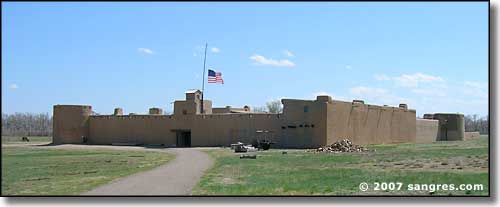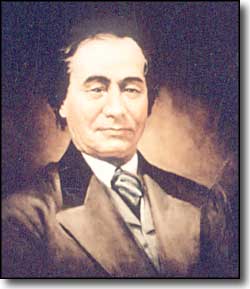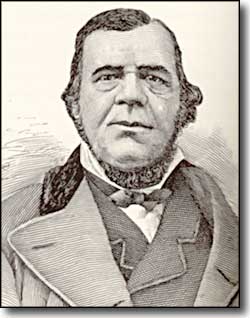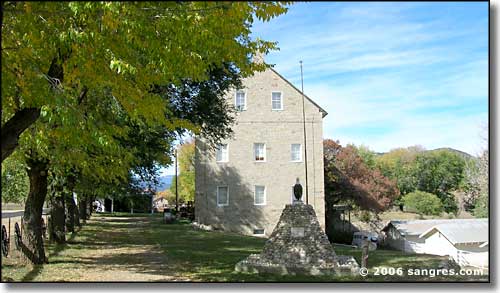 |
Bent, St. Vrain and Company |
|
|
 Bent's Old Fort as it is today |

William and Charles Bent were sons of a wealthy and influential St. Louis judge. They could have lived lives of relative ease in St. Louis but they were drawn by the trading opportunities in the Arkansas River Valley. In 1829 they led a caravan to Santa Fe. A year later they formed Bent, St. Vrain & Company with Ceran St. Vrain, a Taos trader and ex-trapper. Charles directed the Santa Fe trade, taking up residence in Taos and taking seasonal trips to St. Louis. He married into the Jaramillo's, a prominent Taoseño family, and used his influence to increase trade between the Americans and the New Mexicans. In 1846, after General Stephen Watts Kearny took the territory with the Army of the West, Charles was appointed Provisional Governor of New Mexico. In January, 1847, he was killed in Taos in an uprising of Pueblo Indians and New Mexicans. (that's William Bent on the left.) William Bent was at home in the open country of the Upper Arkansas River. Disdaining the hoop-skirted women of St. Louis, in 1837, William married Owl Woman, daughter of a Cheyenne chief. After that, he was continually moving between the two cultures (the Cheyennes knew him as "Little White Man") as he increasingly became more identified with his Cheyenne in-laws. 
George Bent was the son of William Bent and Owl Woman. He spoke English and Cheyenne fluently and attended the finest schools in St. Louis as a boy. As a young man he enlisted in the Confederate army to fight alongside Choctaws and Cherokees. In 1864, at the age of 21, George was captured and paroled home (meaning back to Colorado, no more war). He sought a safe haven with his mother's family at Black Kettle's camp on Sand Creek but he was still there on November 29, 1864 when Colonel John M. Chivington (Union Army officer and hero of the Battle of Glorieta Pass) and his soldiers made a killing sweep through the peaceful camp of unarmed women, children and elderly men. Owl Woman and his brother were killed, George was badly wounded. He remembered the night following the attack as: "the worst I ever went through. There we were on that bleak, frozen plain, without any shelter and not a stick of wood to build a fire with. Most of us were wounded and half-naked. From that time on," he said, "both in war and in peace, I have been with the Cheyennes." George vowed to avenge the massacre and joined with the Dog Soldiers in attacks on freight trains, towns, ranches and military posts. In 1866 he married Magpie, Black Kettle's niece and they had two children. William died on his Purgatory River ranch in May of 1869. George died among the Cheyennes at Colony, Oklahoma, in 1918. Ceran St. Vrain ran the company stores in Taos and Santa Fe and served as American consul in Santa Fe during the 1830's. He also partnered with Cornelio Vigil, a prominent Taos trader and former alcalde (mayor) of Taos, in procuring the Vigil-St. Vrain Land Grant: some 4 million acres spread across south-eastern Colorado. (Cornelio Vigil was also killed in the Taos Uprising) (the drawing to the above right is St. Vrain) Ceran St. Vrain died in 1870. |
 The old grain mill built by St. Vrain in Cimarron, NM, now a museum |
|
The Bent, St. Vrain & Company's Mexican trade grew rapidly as their wagon trains traveled between Independence and Westport, Missouri, and company stores in Santa Fe and Taos where they traded cloth, glass, hardware and tobacco for silver, furs, horses and mules. In 1833, William and his brothers built Fort William on the north bank of the Arkansas River where it was close enough to the Rockies to draw trappers, near the Cheyenne, Arapaho, Kiowa and other tribes for trading, and on the Santa Fe Trail near a ford across the river. As the fur trade declined in the 1830's, the Indian trade became a mainstay of the business and Fort William really came into its own. The Bents' reputation drew growing numbers of Indians to the fort and made their traders welcome in most villages. They dominated the Indian trade on the southern Plains very quickly. Their reputation was such that in 1846, the fort (then known as Bent's Fort) was used as headquarters for the Upper Platte and Arkansas Indian Agency. That year also saw the coming of the Army of the West. The fort's strategic location made it the perfect staging point for the invasion of Mexico's northern province. While this was happening, the traders' storerooms became filled with military supplies, soldiers were quartered all over the fort and their livestock stripped the land bare before the army headed on its' way. Later, a growing stream of goldseekers and other settlers disrupted the carefully nurtured Indian trade. The Cheyennes moved away from the polluted water holes, the decimated cottonwood groves and the declining bison herds. Finally, escalating tensions between the newcomers and the Indians capped by a cholera epidemic killed what was left of the trade and Bent, St. Vrain & Company closed up shop. |
|
|
Bent, St. Vrain & Company Related PagesColorado Pages
Towns & Places - Scenic Byways - State Parks - BLM Sites - History & Heritage
Ski & Snowboard Areas - Photo Galleries - Colorado Mountains - Scenic Railroads Unique Natural Features - Wilderness Areas - Outdoor Sports & Recreation Colorado's National Forests - National Wildlife Refuges - Colorado's National Parks |
 |
| Index - Arizona - Colorado - Idaho - Montana - Nevada - New Mexico - Utah - Wyoming National Forests - National Parks - Scenic Byways - Ski & Snowboard Areas - BLM Sites Wilderness Areas - National Wildlife Refuges - National Trails - Rural Life Sponsor Sangres.com - About Sangres.com - Privacy Policy - Accessibility |
| Images of William Bent and Ceran St. Vrain courtesy Colorado Historical Society. Other photos courtesy of Sangres.com, CCA ShareAlike 3.0 License. Text Copyright © by Sangres.com. All rights reserved. |